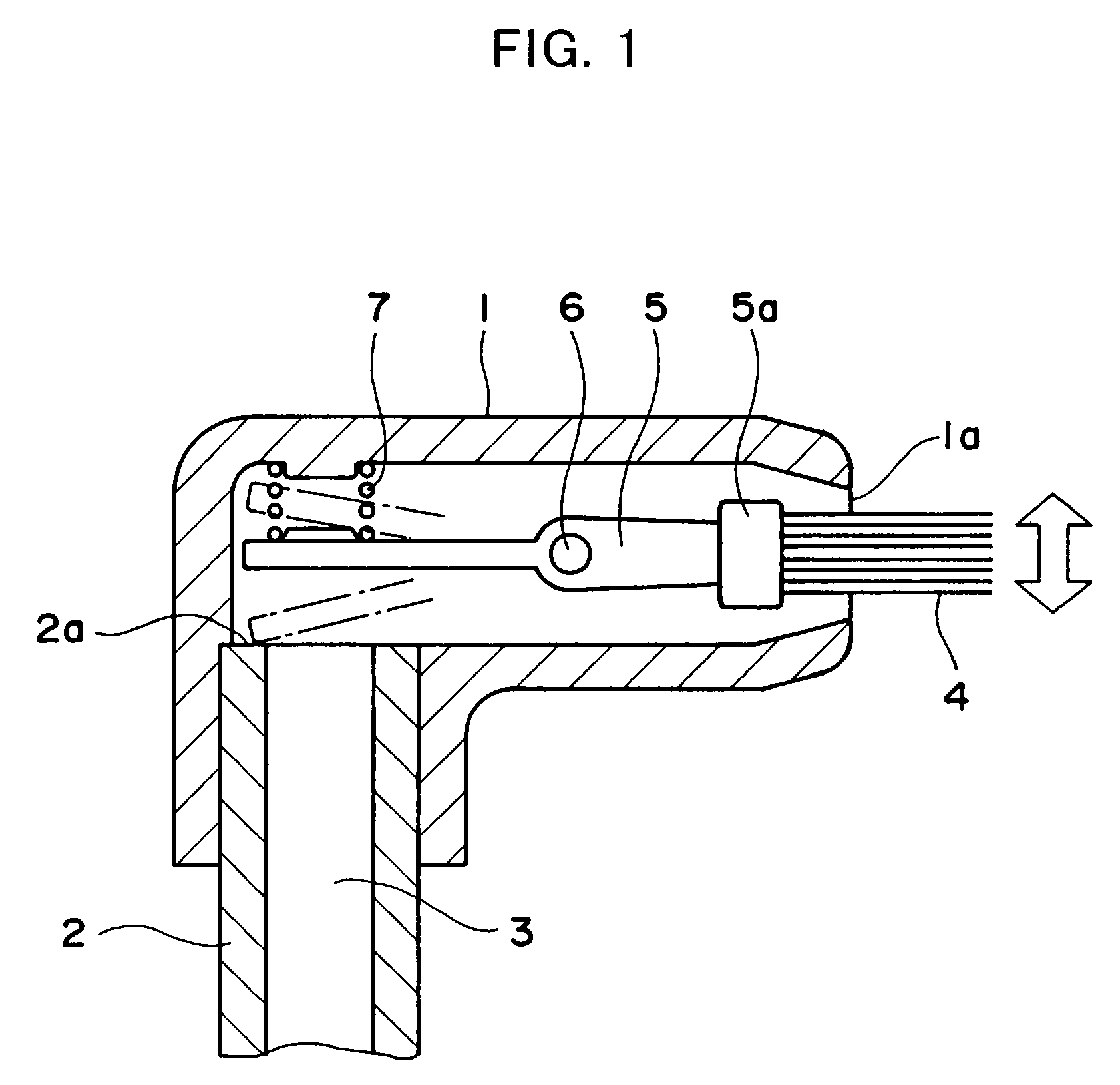Tooth brusher
a tooth brush and tooth brushing technology, applied in the field of tooth brushing devices, can solve the problems of difficult to remove teeth from such portions, consuming too much time for him, and being tired on his arm, and it is not easy to continue the work any longer
- Summary
- Abstract
- Description
- Claims
- Application Information
AI Technical Summary
Benefits of technology
Problems solved by technology
Method used
Image
Examples
first embodiment
[0019]FIG. 1 illustrates the invention, i.e., an embodiment of the invention of claim 1. A nozzle 1 is secured to an end of a main body 2 nearly at right angles therewith, and a flow passage 3 leads to a blow-out port 1a open at an end of the nozzle 1 while being bent nearly at right angles as it goes to the blow-out port 1a from the main body 2.
[0020]Inside the nozzle 1, a brush lever 5 holding a brush 4 at an end core 5a is rotatably supported at its middle portion by a pin 6. The brush 4 is partly protruding maintaining a sufficiently large gap relative to the blow-out port 1a. On the side opposite to the brush 4, a compression coil spring 7 is acting on the rear potion of the brush lever 5, the compression coil spring 7 being a resilient member with its one end being secured to the inner wall surface of the nozzle 1. The rear portion of the brush lever 5 is urged in a direction against the flow of water from the main body 2 due to the compression coil spring 7.
[0021]According to...
second embodiment
[0022]FIGS. 2 and 3 illustrate the invention, i.e., an embodiment of the invention of claim 2. In this embodiment, the opening 1a at the end of the nozzle 1 is not for blowing out the water but is simply for permitting the brush 4 to protrude in contrast with the structure of FIG. 1. Instead, a plurality of blow-out ports 8 are formed to surround the opening 1a. Water from the flow passage 3 flows being branched into these blow-out ports 8 and is blown out simultaneously being directed to the end of the brush 4.
third embodiment
[0023]FIGS. 4 and 5 illustrate the invention, i.e., an embodiment of the invention of claim 3. This embodiment uses a brush rotary shaft 9 holding the brush 4 at an end core 9a instead of the brush lever 5. A middle portion of the brush rotary shaft 9 is supported by a bearing 10 in the nozzle 1, and a rear end thereof is supported by a bearing in a recessed portion 11 in the wall in the nozzle, so that the brush rotary shaft 9 rotates being deviated by a distance L from the center axis of the flow passage 3 in the main body 2. A water-wheel 12 is secured to the brush rotary shaft 9 so as to receive the pressure of water flowing from the main body 2.
[0024]According to the structure shown in FIGS. 4 and 5, the water-wheel 12 receives the pressure of water flowing through the flow passage 3 in a deviated state. Therefore, the brush 4 rotates together with the brush rotary shaft 9 while water is blown out from the blow-out port 1a. In this case, the rotary motion can be converted into ...
PUM
 Login to View More
Login to View More Abstract
Description
Claims
Application Information
 Login to View More
Login to View More - R&D
- Intellectual Property
- Life Sciences
- Materials
- Tech Scout
- Unparalleled Data Quality
- Higher Quality Content
- 60% Fewer Hallucinations
Browse by: Latest US Patents, China's latest patents, Technical Efficacy Thesaurus, Application Domain, Technology Topic, Popular Technical Reports.
© 2025 PatSnap. All rights reserved.Legal|Privacy policy|Modern Slavery Act Transparency Statement|Sitemap|About US| Contact US: help@patsnap.com



